
Subscribe & stay up-to-date with ASF

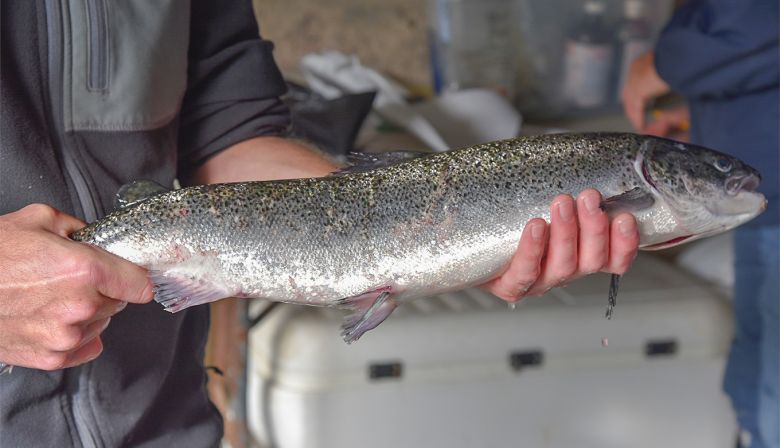
As spawning time nears for wild salmon populations in the Bay of Fundy and Gulf of Maine, a pulse of escaped aquaculture salmon has been detected at the Magaguadavic River fishway in St. George, N.B.
Five fish from industry cages were identified through fin and scale analysis, then culled, with samples being sent for analysis. ASF scientists working with DFO and researchers at the University of British Columbia recently published the first look at the infectious agents carried by aquaculture salmon in this region, finding a concerning array of viruses and bacteria.
Beyond disease, aquaculture salmon chronically escape and have bred with wild fish throughout Atlantic Canada, like along the south coast of Newfoundland and where the Magaguadavic meets salt water – the Bay of Fundy.
The result is offspring less fit for the wild, contributing to population collapse and altering the genetic heritage of wild populations.
Escapes are in the news around the world right now. In western Scotland tens of thousands escaped when four cages were destroyed in North Carradale in Argyllshire.
Th Scottish government is asking anglers to kill the aquaculture salmon and take samples, offering a guide to identifying the escapees.
In Norway there have been even more escapees, and the harm they are doing will last centuries. The Norwegians estimate 3 % to 9 % of salmon entering their rivers since 1989 have been escapees. Most recently, in monitored rivers in 2019 there were 6 % escapees. Their studies have shown that 2/3 of monitored rivers had wild salmon contaminated with aquaculture escapees. In some cases this has led even to altered age and size at maturation for wild fish.
The legacy of escaped salmon is another reminder of the high cost of salmon aquaculture.
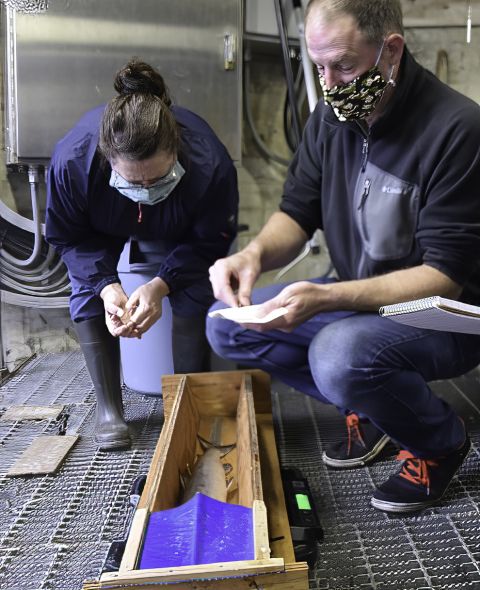
Miramichi and ASF Activity on the River
The water continues low throughout the Miramichi system, with everyone hoping for a major rain event very soon.
During 2020 ASF has remained active in its efforts to both research Atlantic salmon and with its partners to safeguard the future of wild Atlantic salmon through endeavours to remove the very real threat of smallmouth bass, and other issues. Below is a pdf document with an overview.

Less than two weeks are left in the season on most rivers. It will be interesting to see results of the season ending counts to appreciate the very encouraging numbers of fish having migrated back to their home waters.
The data used for the Quebec river notes are sourced from various river websites, social media and Quebec government sources. Information can change without prior notification regarding prior year comparative figures.
Il restera moins de deux semaines avant la fin de cette saison quand ce rapport paraîtra. Les décomptes de fin de saison auront lieu bientôt et vont révéler les derniers détails d’une saison très encourageante et qui s’annonce bien pour la période de fraie.
https://www.facebook.com/icigaspesieilesdelamadeleine/posts/3391927917536263
Les données utilisées dans ce rapport proviennent de divers sites web, des médias sociaux et de sources gouvernementales québécoises. Les informations peuvent changer sans avis au préalable en ce qui concerne les comparatifs des saisons précédentes.

Rivière Cascapédia River
The 2020 salmon angling season is winding down, and fishing continues to be very good.
But when you are chasing silver – okay, admittedly it’s more bronze in the Fall, there are always surprises.
Jeff Bourdages of Rimouski, Quebec, was fishing pool 80 of the “Lake Branch,” on the Cascapedia River last weekend and got quite a shock. As he waded downstream, he stopped to cast and looked down. There at his feet, he saw something that according to him “didn’t belong there.”
It was a white gold diamond infinity band. He later learned that it had been in the river about 10 years. Despite being underwater for a decade it still gave off a slight, if tarnished sparkle, but otherwise did not look any worse for wear.

Jeff knew that Cascapedia anglers are a tight-knit group, so called the Cascapedia Society office to inquire if anyone had reported the loss of such a treasured possession. As fate would have it, Tammy Vicaire, who has worked in the office for many years, answered the phone.
Telling Jeff that no one had reported the loss of a ring. Then she caught herself and paused, suddenly asking him where it was found. As he described the particulars of the piece of jewellery, she flashed back to 10 years prior when she had been fishing in the same area and vividly remembering a spill, she had taken that day. A long and purposeful search had ensued without success.
“My engagement ring was lost forever,” she shared with me over the phone.
To confirm he had found the long-lost ring, Jeff sent along a photograph. Tammy could not believe her eyes, and showed it to Darlene Sexton, Cascapedia Society manager, who screamed out “That’s your ring!”
Jeff will be traveling back to the Cascapedia this weekend with the ring to give it to Tammy. Who knows how much water has flowed over this treasure, and how much ice and deadfall may have bumped and nudged it? No matter now, it is back with its rightful owner and illustrates again how the Cascapedia river always gives back, even if sometimes in the strangest ways.
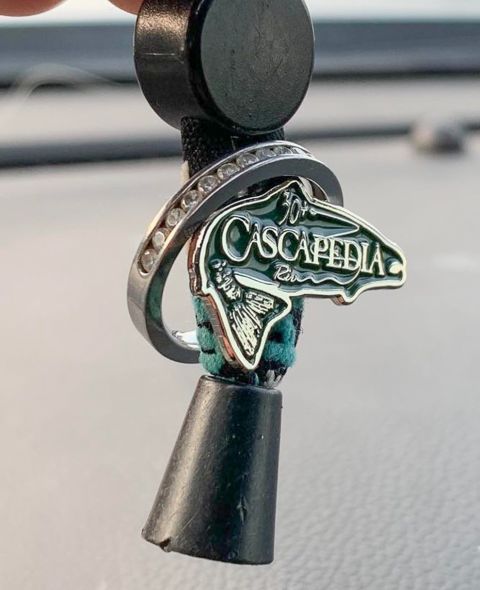
La saison de pêche au saumon 2020 tire à sa fin et la pêche continue d’être très bonne.
Pendant la saison automnale, il y a toujours des surprises lorsque nous sommes à la recherche du saumon atlantique.
Jeff Bourdages, de Rimouski, a fait une découverte inusitée la fin de semaine dernière pendant qu’il pêchait la fosse 80 de la branche du lac sur la rivière Cascapédia. Alors qu’il s’apprêtait à « couvrir » la fosse, il s’arrêta en voyant chose qui selon lui semblait bizarre juste avant d’effectuer un lancer. Là, à ses pieds, il se pencha en étendant sa main vers le fond et ressort un anneau de bande infinie en or blanc munie de diamants. Ce bijou, il a appris plus tard reposait dans la rivière depuis environ 10 ans. « Bien que la bague été sous l’eau pendant une décennie, elle dégageait toujours un léger éclat, bien que terni, mais ne paraissait pas si mal » déclara Jeff.
Il a eu l’idée d’appeler le bureau de la Société Cascapédia afin de s’informer si quelqu’un avait signalé la perte d’un bien si précieux. Comme le destin l’a voulu, Tammy Vicaire, qui travaille au bureau depuis de nombreuses années, a répondu au téléphone.
Tammy explique qu’à sa connaissance, que personne n’avait signalé la perte d’une bague de ce genre. Puis elle se rattrapa et fit une pause, lui demandant soudainement où elle avait été trouvée. Alors qu’il décrivait les détails du bijou, elle est revenue à 10 ans auparavant, alors qu’elle pêchait dans la même zone et se souvenait vivement d’avoir pris une bonne fouille ce jour-là. Une recherche longue et réfléchie s’était ensuivie sans succès. « Ma bague de fiançailles a été perdue à jamais », a-t-elle partagé avec moi au téléphone.
Jeff a envoyé une photo afin de confirmer qu’il avait retrouvé la bague perdue depuis longtemps. Tammy n’en croyait pas ses yeux et l’a montrée à Darlene Sexton, directrice de la société Cascapedia, qui a crié « C’est ta bague! »
Jeff retournera la bague cette fin de semaine pour la remettre à Tammy. Pendant la dernière décennie, combien d’eau a coulé sur ce trésor, combien de glace et de branches d’arbre l’ont heurté et déplacé, qui sait?
Peu importe, la bague sera réunie avec sa propriétaire légitime illustrant à nouveau comment la rivière Cascapédia est toujours généreuse à sa manière, pour ceux qui la côtoient.
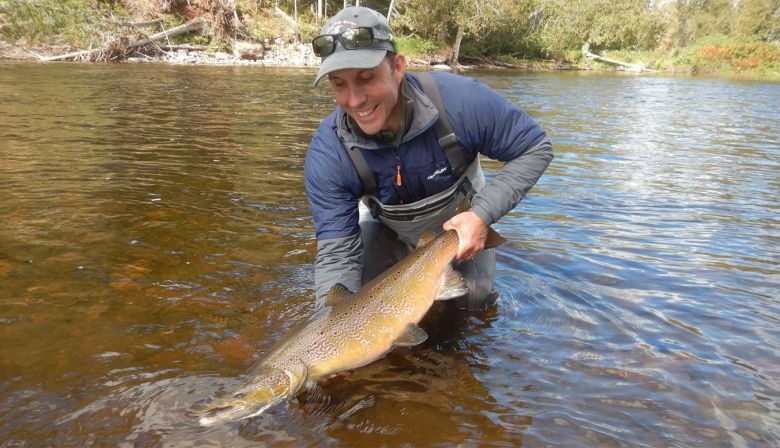
Rivières York, Dartmouth, St-Jean Rivers
Most recent catch statistics are available at:
https://saumongaspe.com/en/peche-saumon-gaspe/statistiques.html
Les statistiques récentes des prises peuvent être consultées au :
https://saumongaspe.com/peche-saumon-gaspe/statistiques.html
Rivière Matane River
Fresh fish continue to enter the Matane which continues to pad already very good migration numbers for this season. As of September 13th, 2,660 fish (1,652 salmon and 1,008 grilse) have been counted to date in 2020. Anglers have reported landing a total of 789 fish comprised of 295 salmon and 95 grilse released, 134 salmon and 305 grilse harvested.
To September 17th, 2019, 1,926 (1,212 salmon and 714 grilse) were counted through the fishway. To the same date, 217 salmon and 45 grilse have been released along with 125 salmon and 271 grilse reported harvested for a grand total of 658.
La montaison de saumon frais continue en ce moment, ces poissons viennent s’ajouter aux très bons résultats migratoires de cette saison. Cumulativement au 13 septembre, 2 660 poissons (1 652 saumons et 1 008 madeleineaux) ont été dénombrés à ce jour en 2020. Les pêcheurs sportifs ont déclaré la capture de 789 poissons, dont 295 saumons et 95 madeleineaux relâchés, 134 saumons et 305 madeleineaux récoltés.
Au 17 septembre 2019, 1 926 (1212 saumons et 714 grils) ont cumulativement été comptés par le biais de la passe migratoire. À la même date, 217 saumons et 45 madeleineaux avaient été relâchés, ainsi que 125 saumons et 271 madeleineaux récoltés pour un total de 658.

Rivière Matapedia River
To September 13th, for the season, a total of 1,247 fish have been reported landed by anglers. Of those, 742 have been released and 505 harvested.
To September 16th, 2019, cumulatively, 1,170 fish had been reported landed (721 large salmon released, and 449 grilse harvested).
Au 13 septembre, un total de 1 247 poissons ont été déclarés capturés par les pêcheurs sportifs. Parmi ceux-ci, 742 ont été relâchés et 505 ont été récoltés.
Comparativement au 16 septembre 2019, au total, 1 170 poissons avaient été capturés dont 721 grands saumons relâchés et 449 madeleineaux récoltés).
Rivière Mitis River
The new fish trap installed prior to the 2020 migration has proven to be very effective and has performed very well during the different flow levels this angling season.
As of September 13th, 760 salmon and 758 grilse have been counted for a total of 1,518 fish. On the angling side, 328 fish have been reported landed comprised of 133 released and 195 harvested.
To September 16th, 2019, 885 fish (457 large salmon and 430 grilse) were transported up above the natural waterfall. Also, to date, 104 large salmon have been released and 112 grilse had been reported harvested for a total of 216.
Le nouveau piège à saumons installé avant la migration de 2020 s’est avéré très efficace et a très bien fonctionné pendant les différents niveaux de débit cette saison de pêche.
Au 13 septembre, cumulativement, 760 saumons et 758 grils ont été dénombrés pour un total de 1 518 poissons. Du côté de la pêche sportive, 328 captures ont été déclarées, dont 133 saumons relâchés et 195 récoltés.
Pour la saison 2019, au 16 septembre, 885 poissons (457 gros saumons et 430 grils) ont été transportés en amont. De plus, à ce jour, 104 saumons ont été relâchés et 112 madeleineaux ont été récoltés totalisant 216 captures.
Rivière Bonaventure River
As water conditions were very good, an in-river count was performed on September 11th and 12th resulting in 1,834 fish (1,531 salmon and 303 grilse) being observed and counted. Compared to 1,412 fish counted (1,047 salmon and 365 grilse) resulted from the 2019 season.
Les conditions de débit étant favorable, le décompte de fin de saison fut complété le 11 et 12 septembre dernier, résultants d’un dénombrement de 1,531 saumons et 303 madeleineaux totalisant 1,834 poissons. Le décompte de cette saison se compare bien lorsqu’en 2019, 1,047 saumons et 365 madeleineaux totalisant 1,412 poissons furent dénombrés.
The water level is up from about three weeks ago, but dropping fast again. With rain expected and the cooler temperatures, I’m thinking we will continue to have excellent salmon anglingconditions.
My largest fish this year was approximately 42-44 in. in length. I only had a very quick rod measure on the fish while still moving and rolling around.
I just wanted to get the fish into the proper current and released safely so I did not continue with a measure. I did not have a girth on the fish but the two gentlemen that were there that morning, both having fished the Humber for 30+ years, claimed it to be the thickest and even largest fish they had personally seen landed in their lives).
Almost every large fish we have seen this year has had significant girth. Even some of the shorter fish 30-32” were as thick if not thicker than some of the 36+ lengths we saw last year.
Back to the large fish…
It was caught with a #8 line – G Loomis Asquith Rod. 10lb clear leader and a size 4 Orange Bomber.
Fish jumped about 7 times in total. Completely out of water (which we all thought was quite unusual for a large fish…especially this size) The fish jumped about 5-6 times in the beginning and once later in the near hour-long fight.
Water was average level (I’m not sure exactly what it was that day or week. But I do know the temp was 16.5 degrees at the beginning of that morning when I started fishing at 5:40am. Fish was hooked around 6am landed close to 7.
If I had to compare the water to two weeks ago, I’d say it’s currently lower.
Gander River
Tolson Parsons said yesterday:
Water conditions on the Gander are quite high and not good fishing. However the high water is a pleasure to see, since we had a dry summer. Lets hope lots of fish reach their spawning areas.
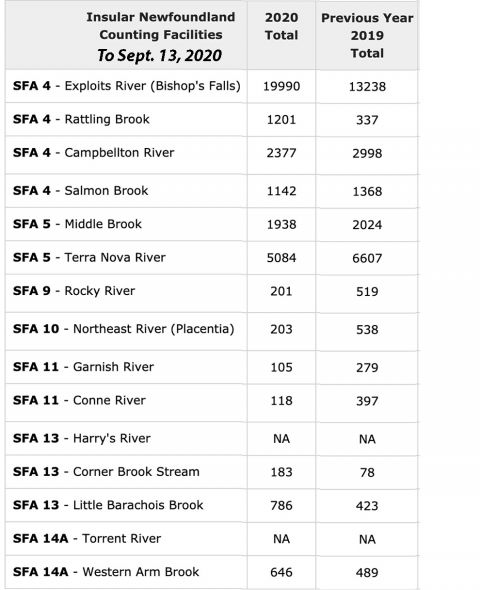
The Newfoundland and Labrador counts have been posted to Sept. 13, and overall there has been good news on the counts.
The Exploits very fortunately has come back strong in 2020 with 19,990 vs 13,238 in 2019.
Rattling Brook with its great success story has now reached 1,201 Atlantic salmon. As regular readers know, this is the highest return count in the 10 years of restoration and conservation work undertaken.
Eastern and southern rivers give some concern, with Northeast River (Placentia) having just 203 return, vs 538 last year. VERY low numbers on the Conne with 118 counted, when there should be at least a thousand or two. The Garnish River has only seen 105 salmon.
West coast streams appear to b doing better. So good to see Corner Brook Stream with a healthy new record of 183.
Little Barachois Brook in the Bay St. George area has had 786, almost double last year’s 423, and Western Arm Brook has had 646. Still could do better, but improved from 489 last year.
Note that DFO Covid-19 procedures interfered with counts at the Torrent River and Harry’s River, both on the west coast.

Nothing new in Labrador, with the counts much better in 2020 than 2019.
Certainly all the indications are that survival at sea this past winter was better for most populations, both in North America and Europe.

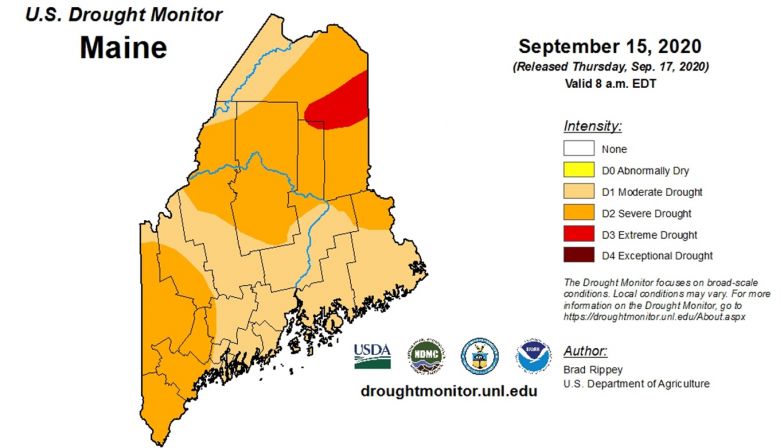
Penobscot
Jason Valliere, Biologist of the Maine Department of Marine Resources writes:
Current Atlantic salmon estimate is 1,453.
This includes 604 Males and 632 females large salmon, and 217 grilse. 221 fish (190 MSW and 31 Grilse) have been sent to the hatchery for broodstock.
Counts have not been adjusted for in-season recaptures based on PIT Tag, Radio Tag, or proration. Counts will be adjusted as data become available.
Downeast Rivers
Biologist Colby Bruchs notes that no new Atlantic salmon have come in and water flows remain critically low.

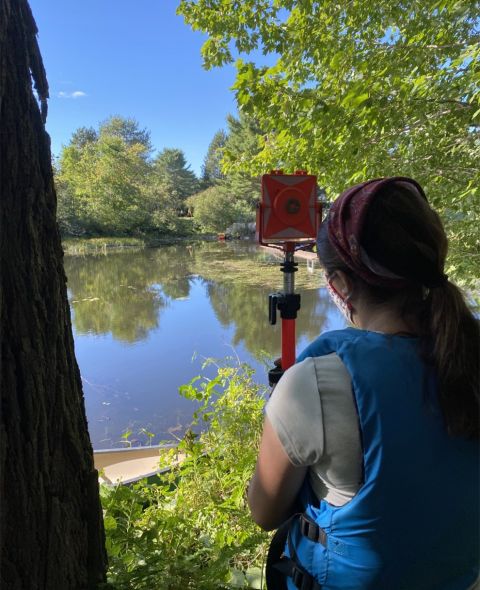
Walton’s Mill Dam
Bill Bennett of the USFW has been working with students from the University of Maine Farmington in surveying the Walton’s Mill project area. ASF, along with USFW and UMF are continuing preparation work for the removal of the dam.